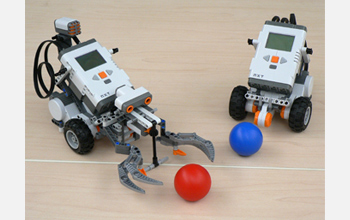All Images
News Release 08-209
An ACE for Visually Impaired Students in Computer Science
Project works to increase participation of visually impaired students in computer science
This material is available primarily for archival purposes. Telephone numbers or other contact information may be out of date; please see current contact information at media contacts.

Visually impaired students work through a computing challenge at ImagineIT, a workshop developed by Project ACE at the Rochester Institue of Technology to give visually impaired students some of the foundations they need to successfully study computer science in college.
Credit: Courtesy of Stephanie Ludi, Rochester Institute of Technology
Download the high-resolution JPG version of the image. (3.4 MB)
Use your mouse to right-click (Mac users may need to Ctrl-click) the link above and choose the option that will save the file or target to your computer.
Visually impaired students face a number of challenges when it comes to pursuing degrees and careers in computer science. Enter Project ACE, an initiative based at the Rochester Institute of Technology (RIT) that is working to help visually impaired students navigate these challenges and achieve success. In this interview, Project ACE co-principle investigators Stephanie Ludi and Thomas Reichlmayr, both professors of software engineering at RIT, discuss the importance of including these students in the field of computer science and their experiences hosting ImagineIT, a workshop for visually impaired students. They are joined by Jeremy Leakakos, a student at RIT who also worked with the workshop participants.
Credit: National Science Foundation/Rochester Institute of Technology

The visually impaired students who took part in the ImagineIT workshop at the Rochester Institute of Technology programmed robots like these to be able to perform tasks such as handling balls and navigating a maze.
Credit: Courtesy of Stephanie Ludi, Rochester Institute of Technology.
Download the high-resolution JPG version of the image. (4 MB)
Use your mouse to right-click (Mac users may need to Ctrl-click) the link above and choose the option that will save the file or target to your computer.
